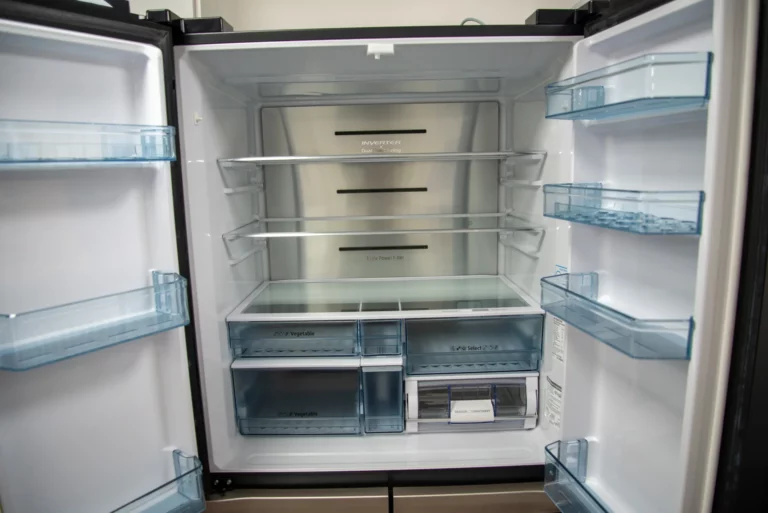Introduction
Refrigerators are an essential appliance in every household, responsible for preserving food freshness and preventing spoilage. Setting the right temperature in your refrigerator is crucial to achieve optimal results. This article will guide you through optimizing your refrigerator’s temperature for food safety and energy efficiency. By understanding the recommended temperature range, the impact on food quality, and implementing practical tips, you can ensure your refrigerator functions at its best.
Regularly clean and defrost your refrigerator to ensure optimal performance and energy efficiency. Excess frost buildup can impede airflow and force the appliance to work harder to maintain desired temperatures. Additionally, check door seals for signs of wear and tear, as a tight seal is essential for preventing cold air from escaping and warm air from entering.
The Ideal Refrigerator Temperature
Maintaining the ideal temperature range is key to preserving food freshness and preventing bacterial growth. The recommended temperature for most refrigerators falls between 35°F (1.7°C) and 38°F (3.3°C). Within this range, perishable foods stay fresh for longer, reducing the risk of foodborne illnesses. Fluctuations in temperature can lead to food spoilage, so it is crucial to maintain a consistent temperature to optimize food preservation.
Food Safety and Refrigerator Temperature
Storing food at incorrect temperatures poses risks to food safety. Refrigerators set at temperatures above 40°F (4.4°C) may allow bacteria to multiply rapidly, increasing the chances of foodborne illnesses. It is important to store different types of food items at specific temperatures. For example, raw meat should be kept at temperatures below 40°F (4.4°C) to minimize bacterial growth, while fruits and vegetables may require slightly higher temperatures to maintain their quality.
Also read: Which is colder in fridge 1 or 5
Energy Efficiency and Refrigerator Temperature
The temperature you set in your refrigerator can significantly impact its energy consumption. Lowering the temperature unnecessarily wastes energy and puts a strain on your utility bills. Adjusting your refrigerator’s temperature to the recommended range allows you to maximize energy efficiency without compromising food quality. Additionally, organizing the contents of your refrigerator properly promotes better airflow, reducing the workload on the appliance.
Refrigerator Maintenance and Temperature Control
Regular maintenance is vital in ensuring your refrigerator operates at the desired temperature. Keeping the condenser coils clean and free from dust buildup is important, as this can affect temperature control. If you notice frequent temperature fluctuations, check the gaskets around the refrigerator door for damage or leaks. Organizing your refrigerator with proper spacing and avoiding overcrowding allows for better airflow, and maintaining a consistent temperature throughout.
Technological Innovations and Temperature Management
Advancements in refrigerator technology have revolutionized temperature management. Smart refrigerators with sensors and adaptive cooling systems ensure precise temperature control, preventing fluctuations and maximizing the freshness of food. Some models even offer temperature monitoring apps, allowing you to monitor and adjust the temperature remotely. These innovations improve convenience and contribute to energy efficiency by optimizing cooling processes.
Conclusion
Setting the right temperature in your refrigerator is crucial for both food safety and energy efficiency. By adhering to the recommended temperature range, implementing proper storage practices, and taking advantage of technological advancements, you can optimize the performance of your refrigerator. Maintaining food freshness, preventing bacterial growth, and reducing energy consumption are achievable goals when you prioritize temperature control in your refrigerator.
Apart from this, if you are interested to know more about Eco-Friendly Homes then visit our Home Improvement category
FAQs
Look for a built-in thermometer or use an appliance thermometer placed in a glass of water inside the refrigerator. It should read between 35°F (1.7°C) and 38°F (3.3°C) for optimal results.
Yes, different types of produce have specific temperature requirements. Storing fruits and vegetables at temperatures too low or too high can affect their quality and accelerate spoilage.
Check the door gaskets for damage or leaks, clean the condenser coils, and ensure proper airflow by organizing the contents of your refrigerator. If the issue persists, consult a professional technician.
Yes, many manufacturers offer energy-efficient refrigerators with features like inverter compressors, LED lighting, and advanced insulation. Look for ENERGY STAR certified models for maximum efficiency.
Yes, extremely low temperatures can cause freezing in certain areas, particularly near the back or sides of the refrigerator. It is important to set the temperature within the recommended range to prevent freezing while maintaining food safety.
